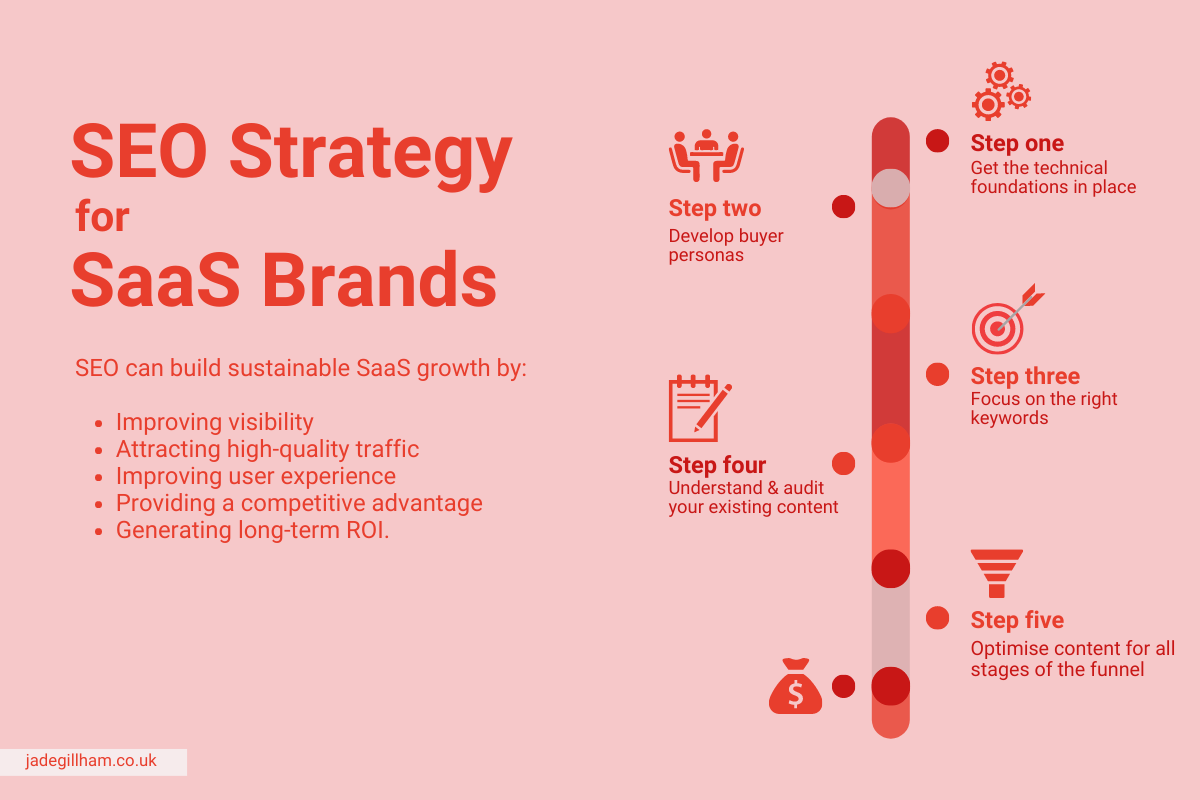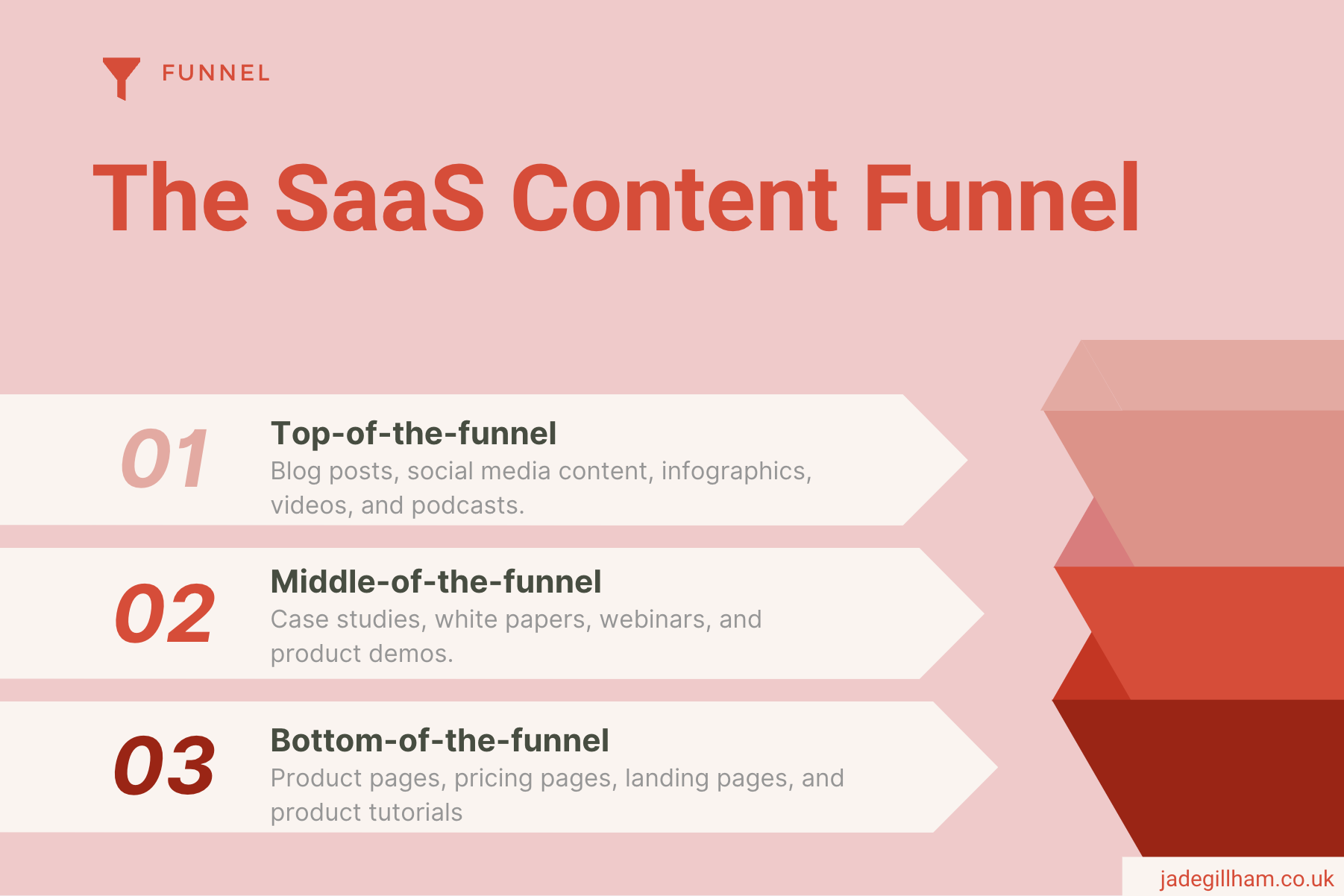Unlocking the power of SEO for SaaS
Are you a SaaS brand looking to enhance your online presence? If so, then you must have a solid SEO strategy in place. SEO can help you achieve your desired results, but how do you design an effective strategy? In this post, I’ll share some valuable insights and tips on how to develop a successful SEO strategy for your SaaS brand that’ll help you get the most out of your SEO efforts.
The impact of SEO on SaaS: Why it matters more than you think
SEO can provide several benefits for sustainable SaaS growth by improving visibility, attracting high-quality traffic, improving user experience, providing a competitive advantage, and generating long-term ROI.
Increased visibility and traffic: This can result in increased organic traffic to your website which can lead to more sign-ups, trials, and sales.
Higher quality traffic: By targeting specific keywords and phrases related to your product or service, you can attract more engaged visitors who are more likely to convert into customers.
Improved user experience: Optimise your website for better user experience, which can lead to increased engagement, longer visit durations, and lower bounce rates.
Competitive advantage: Outperform your competitors in search rankings to help you establish your business as an authority in your industry and build trust with potential customers.
Sustainable growth: Attract targeted traffic that is more likely to convert and remain loyal customers. This can also result in lower customer acquisition costs and a higher customer lifetime value.
Long-term ROI: Generating leads and sales without the ongoing cost of paid ads can result in a higher return on investment over time.
Enterprise SEO strategy for SaaS brands

Get the foundation in place
First and foremost, you need to build a user-friendly site for people to book a demo, download your brochures, contact customer support, and just read content.
Some technical fundamentals your website needs include:
- Crawlability and indexing
- Site architecture
- Page titles and H1 headings
- Structured data
- Broken links & duplicate content
- Image optimisation & page speed
Develop your buyer persona
Next, your team should create a list of buyer personas you will pursue. Your B2B personas will likely target specific people in an organisation, such as managers or directors.
Once you have a list of buyer personas, you can create strategic campaigns with actionable solutions that appeal to these personas on both paid and organic channels.
Input for buyer personas includes:
- Sales, marketing and customer service teams
- Existing analytics sources (e.g., Google Analytics, Google Search Console, or paid media channels)
- Direct feedback from customer surveys and interviews
Focus on the right keywords
Since the acquisition cost for SaaS providers is often incredibly high, you need to curate a strategic organic keyword strategy that brings in qualified traffic to your website.
Some strategies to generate high-converting keywords and to use them appropriately include:
- Target a list of your highest-converting PPC keywords
- Analyse what keywords competitors are bidding on and targeting organically
- Optimise for informational keywords (e.g., photo editing software: “How to enhance a photo”).
- Leverage “integration” related terms if your software works with other products
- List features (e.g., photo editing, red-eye removal, cropping, etc.)
- Segment target keywords by intent across your sales funnel (e.g., informational keywords at the top of the funnel and keywords about features/benefits for mid-funnel content).
- Optimise for lower volume, niche keywords with less competition
Understand your existing content
Now you have your buyer personas and target keywords in place you can audit your existing content and blogs to determine what you already have covered, what content can be repurposed, and where the gaps are.
You probably have some existing content that can be optimised and edited to fit your plan.
Optimise content for all stages of the funnel
SaaS businesses should focus on creating content that addresses the needs and pain points of your target audience at each stage of their buying journey. This will help your SaaS business to attract your target audience, nurture leads, build trust, and convert visitors into paying customers.

How can you optimise for each stage of the marketing funnel?
Top-of-the-funnel (TOFU): The goal here is to attract visitors to the website and introduce them to the brand. SaaS businesses should create educational, informative, and entertaining content that addresses the pain points and interests of your buyer personas.
Content types: Blog posts, social media content, infographics, videos, and podcasts.
Middle-of-the-funnel (MOFU): At this stage the goal is to nurture leads and build trust with the brand. You should create content that provides in-depth information about your brand’s product or service and highlights its unique selling points.
Content types: Case studies, white papers, webinars, and product demos.
Bottom-of-the-funnel (BOFU): Now it’s time to convert. Here you should create content that’s focused on sales and encourages users to take action, like signing up for a trial, booking a demo or making a purchase.
Content types: Product pages, pricing pages, landing pages, and product tutorials.
3 SaaS SEO tactics that really work
1. Start with the low hanging fruit
Targeting keywords that you rank for in positions 11 to 20 are low-hanging fruit and provide quick wins to improve your performance.
2. Expand on your content
Once you’ve identified those low hanging fruit, you can expand the current content to meet end user intent and make it super relevant. This is especially important if you have pages with little or thin content.
3. Use topic clusters
Creating topic clusters around topics with similar content is a highly effective strategy for improving SEO and establishing authority on a particular topic.
Creating comprehensive content that covers a range of subtopics and related questions allows your SaaS business to answer as many user questions as possible and demonstrate your expertise on a particular topic.
Tie everything together across multiple channels
Each element of the SaaS SEO strategy mentioned here shouldn’t happen in a silo. It should form part of a well-rounded plan to deliver a consistent marketing strategy that nurtures users from awareness to the decision stage.
Using a mix of PPC and paid social for brand exposure, content to build authority, and organic SEO to scale customer acquisition will provide the best strategy to scale an early-stage SaaS business.
Get in touch if you’re looking for some support with your enterprise SEO strategy.